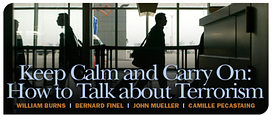It might be good to request some specifics. I very much agree with William Burns that for Americans “the probability of being harmed” by terrorists is “extraordinarily small,” that “we need solid risk communication” about it, and that effective communication “should foster resilience and not fear.” The question is, what messages does the research on risk communication suggest would be effective at reducing exaggerated perceptions of risk, what messages would foster resilience without exacerbating fear?
Unlike Burns, officials appear to think the public is insufficiently concerned about being harmed by a terrorist. At any rate that is a reasonable conclusion from an assessment of their efforts over the years at risk communication.
For example, on the first page of its defining manifesto issued in 2002, the Department of Homeland Security officially informed us that “Today’s terrorists can strike at any place, at any time, and with virtually any weapon.” And in 2003 FBI head Robert Mueller proclaimed that “the greatest threat is from al‑Qaeda cells in the U.S. that we have not yet identified,” that the threat from those unidentified entities was increasing, and that they had both “ability and the intent to inflict significant casualties in the US with little warning” and would “probably continue to favor spectacular attacks.” Although such hysterical warnings have become less frequent in recent years, the process remains one in which, as Ian Lustick puts it, the government “can never make enough progress toward ‘protecting America’ to reassure Americans against the fears it is helping to stoke.”
I gather Burns would disapprove of this process. But what specifically would he propose in its place? For example, suppose one followed the assertion that “Today’s terrorists can strike at any place, at any time, and with virtually any weapon” with this: “However, at present rates, your lifetime chances of being killed by an international terrorist is one in 75,000.” Would the added observation lower anxieties productively? Raise them counterproductively? Make no difference? As a matter of public policy, should officials routinely include the second statement in their utterances because it happens to be true regardless of the consequences?
In the meantime, I remain a bit unconvinced by Burns’ remarkable suggestion that Franklin Roosevelt’s 1933 statement about fearing fear may have had the “momentous unintended consequence” of preparing Americans to fight the world war that was thrust upon them almost nine years later. However, a potentially instructive episode in failed communication stems from that war.
After Pearl Harbor, that generation’s 9/11, Americans tended to envision the worst, and rumors quickly spread that the entire Pacific Fleet had been sunk. Unnecessarily concerned that this might hurt morale, Roosevelt went on the radio two months after the attack trying to reduce the alarm ‑‑ the way, suggests Burns, we should now seek to reduce excessive alarm over terrorism. In his effort, Roosevelt assured his listeners that only three combatant ships had been put permanently out of commission and that all the rest were under repair or had already rejoined the fleet. Roosevelt’s facts were utterly correct ‑‑ actually one of the three destroyed ships was being used at the time by the Navy for target practice and probably shouldn’t even have been included. However, mere facts as put forward by a trusted high public official obviously had no effect. Even today, the early, massively exaggerated, estimates routinely prevail in discussions of the attack.

